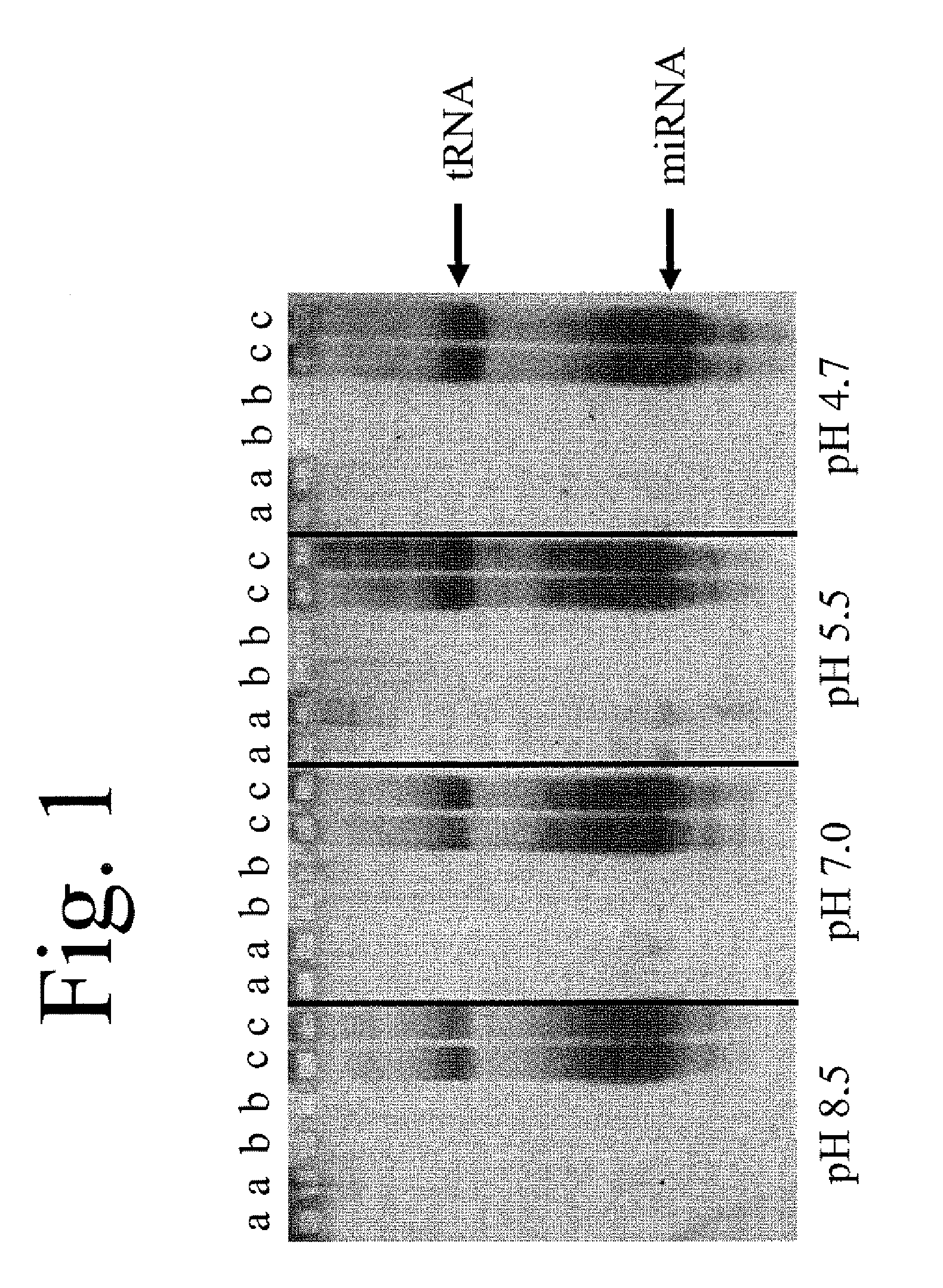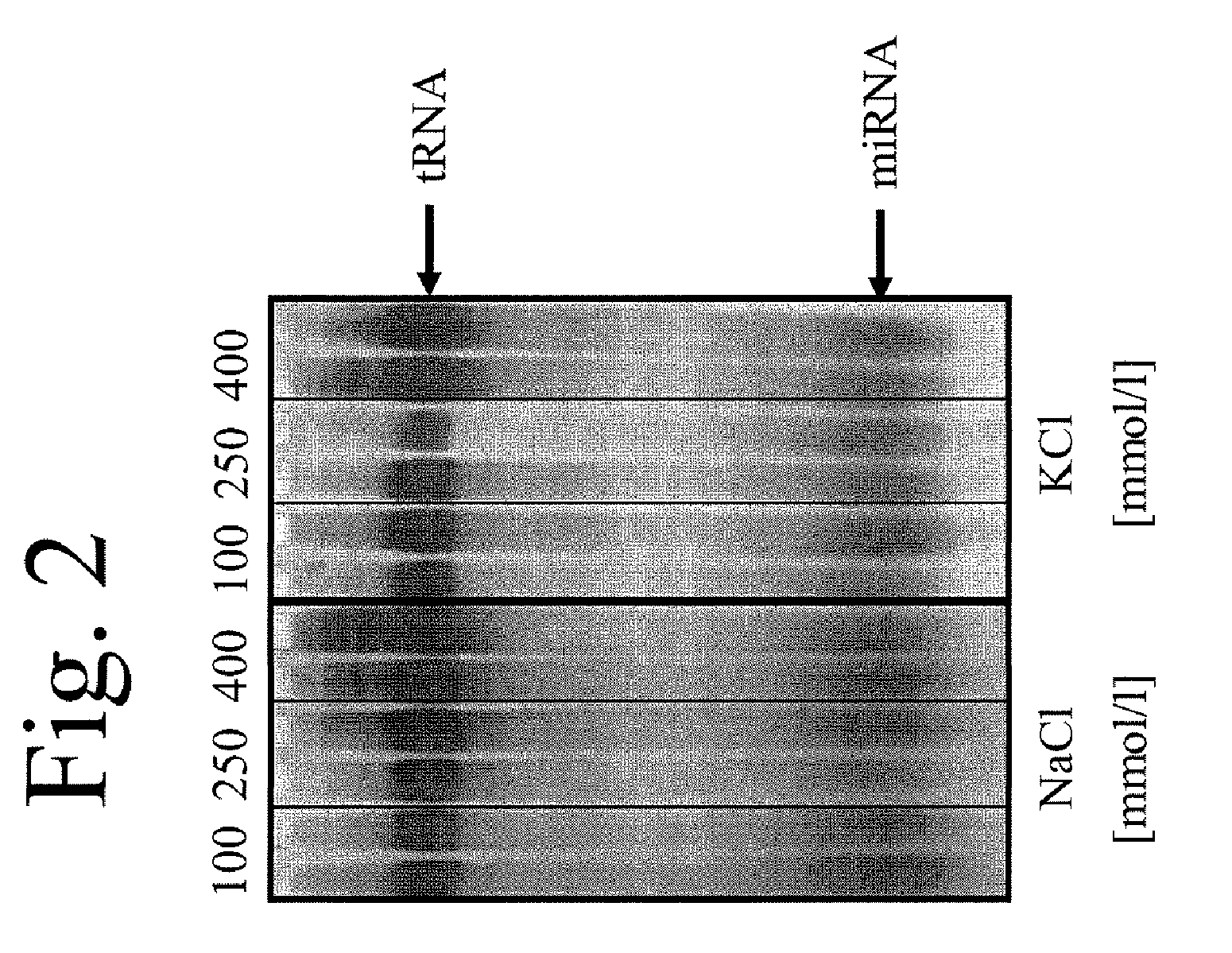Method for enriching short-chain nucleic acids
a technology of short-chain nucleic acids and enrichment methods, which is applied in the field of enrichment methods for nucleic acids, can solve the problems of not being able to obtain only the desired small rna, not being able to isolate or at least insufficiently in all of these methods, and the amount of alcohol in the purification methods described in the prior art is too low to efficiently bind small nucleic acids,
- Summary
- Abstract
- Description
- Claims
- Application Information
AI Technical Summary
Benefits of technology
Problems solved by technology
Method used
Image
Examples
example 1
[0109]106 Jurkat cells were mixed with 1 μg of miR177 antisense miRNA and lysed with the aid of 550 μl of a lysis buffer containing 0.5 M NaCl, 1% (v / v) Triton X-100. After incubating on ice for 10 minutes, 550 μl of acidic phenol were added. Vortexing was followed by centrifugation at 20 800×g for 5 minutes, the aqueous phase was removed and mixed with 652 μg of magnetic particles coated with polyethylenimine.
[0110]The particles were obtained by suspending 4 g of epoxide-functionalized magnetic particles (M-PVA E0x particles from Chemagen AG, Baesweiler, Germany) in 50 ml of a 10% strength high molecular weight polyethyleneimine solution (Sigma-Aldrich, Aldrich Cat No. 40,872-7) in water, pH 10, transferred to a round bottom flask and heated to 60° C. with stirring for 10 hours. This mixture was then washed six times with desalted water with magnetic removal.
[0111]After shaking on a plate shaker for 5 minutes, the supernatant was discarded followed by washing twice with 500 μl of w...
example 2
[0113]106 Jurkat cells were mixed with 1 μg of let7a antisense RNA, lysed and bound to magnetic particles, as specified in Example 1. After two washing steps with water, elution was carried out with 20 μl of buffer, 100 mmol / l NaCl, 250 mmol / l NaCl, 400 mmol / l NaCl, 100 mmol / l KCl, 250 mmol / l KCl and 400 mmol / l KCl being used as elution buffer. Aliquots of the eluates were applied to a 15% polyacrylamide gel and stained with silver nitrate (FIG. 2).
[0114]This experiment reveals that salts at different molarities are suitable for elution. When using NaCl, KCl and LiCl (data not shown) as elution buffer, both tRNAs and miRNAs can be purified in high quantities.
example 3
[0115]The procedure was as in Example 2, using buffers containing from 10 to 100 mmol / l MgCl2 as elution buffers. Aliquots of the eluates were applied to a 15% polyacrylamide gel and stained with silver nitrate (FIG. 3).
[0116]This experiment demonstrates that miRNAs can also be purified with the aid of MgCl2 as elution buffer. If low molarities of MgCl2 are used as elution buffer, the tRNAs and longer nucleic acids are comparatively diluted, while the miRNAs can be recovered with very good yields.
PUM
| Property | Measurement | Unit |
|---|---|---|
| Molar density | aaaaa | aaaaa |
| Dissociation constant | aaaaa | aaaaa |
| Concentration | aaaaa | aaaaa |
Abstract
Description
Claims
Application Information
 Login to View More
Login to View More - R&D
- Intellectual Property
- Life Sciences
- Materials
- Tech Scout
- Unparalleled Data Quality
- Higher Quality Content
- 60% Fewer Hallucinations
Browse by: Latest US Patents, China's latest patents, Technical Efficacy Thesaurus, Application Domain, Technology Topic, Popular Technical Reports.
© 2025 PatSnap. All rights reserved.Legal|Privacy policy|Modern Slavery Act Transparency Statement|Sitemap|About US| Contact US: help@patsnap.com



